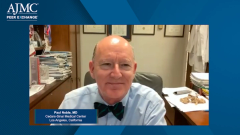
Interstitial Lung Disease: An Overview
Paul Noble, MD, and Daniel Culver, DO, explain the definition of interstitial lung disease (ILD), as well as certain conditions that fall within that distinction.
Episodes in this series

Ryan Haumschild, PharmD, MS, MBA: Hello, and welcome to this AJMC® Peer Exchange program titled “Treatment and Management of Interstitial Lung Disease.” I’m Ryan Haumschild, the director of pharmaceutical services at Emory Healthcare in the Winship Cancer Institute [in Atlanta, Georgia]. Joining me for this discussion are my colleagues Dr Daniel Culver, the chair of the department of pulmonary medicine at Cleveland Clinic [in Cleveland, Ohio]; Dr Kristin Highland, the director of the rheumatic lung disease program at Cleveland Clinic; and Dr Paul Noble, [the Vera and Paul Guerin Family] Distinguished Chair of pulmonary medicine at Cedars-Sinai medical center [in Los Angeles, California]. Today our panel of experts will explore the clinical and economic burden of interstitial lung disease [ILD]. We’ll also review treatment paradigms and standard-of-care therapies. Lastly, we’ll discuss unmet needs in future directions in the treatment of interstitial lung disease. Thank you for joining us. Let’s begin.
As we jump into interstitial lung disease, it’s important that we establish what is an interstitial lung disease, how it is classified, and what some of the key differences are in the classifications and how they relate to one another. Dr Culver, you have a lot of experience in interstitial lung disease. Can you tell us how it’s classified and what the key differences are [between the classifications]?
Daniel Culver, DO: Thanks for having me. Interstitial lung diseases are a group of lung diseases affecting the parenchyma of the lung. We think about the parts of the lung with the alveoli and the ability of the alveoli to transfer gas into the bloodstream. These are in distinction to airways-based lung diseases or diseases that are primarily affecting the vasculature. Interstitial lung diseases are characterized by a combination of scarring or of inflammation, and various lung diseases have different proportions of those.
Depending on how you want to slice and dice it, there are between 50 and 200 interstitial lung diseases. All of these can cause difficulties with exchange of gas so that oxygen doesn’t get into a vasculature. They can cause stiffening of the lung, and of course the symptoms that are obtained from that. The interstitial lung diseases do have differences. They behave differently, and we think some of the pathophysiology is different as well. There’s a tension in interstitial lung disease between lumping and splitting. We’ll hear a lot more about that during this session. The paradigmatic interstitial lung disease is idiopathic pulmonary fibrosis, which is also the most common interstitial lung disease and the most deadly 1. It’s characterized by progressive scarring in the lungs, often relatively inexorable.
On the other end of the spectrum, there are interstitial lung diseases that are almost entirely dominated by inflammation that are approached much differently. We believe it’s important to distinguish these interstitial lung diseases from one another because the prognosis and therapy for them vary quite a bit. The therapies could include medications but also things like eliminating exposures that cause the interstitial lung disease, like occupational exposures, cigarette smoke, or certain medications. As interstitial lung disease experts, we spend a lot of time trying to sort out exactly how interstitial lung disease is affecting a given patient, in terms of therapy and how we can discuss the disease with the patient.
The interstitial lung disease we’re focusing on today—idiopathic pulmonary fibrosis, or IPF; progressive fibrosing interstitial lung disease, or PFILD; and scleroderma-related interstitial lung diseases—are among the most common. I should point out that progressive fibrosing interstitial lung disease is a relatively new term, and it gets to the concept of the idea of lumping. There are several interstitial lung diseases, and all result in fibrosis. In fact, fibrosis progresses or continues despite relatively or seemingly good control of the inflammatory component of the disease. We’ll get more into PFILD as we go along, but that’s broadly how I think about them.
Ryan Haumschild, PharmD, MS, MBA: Excellent. Thanks for that overview. It’s really helpful because it sets the stage for our conversation. I have 1 more question. Paul, maybe you can chime in. Is there a consensus agreement on the classifications that Dr Culver just went through? Would you agree with that? Is there anything you want to add or change?
Paul Noble, MD: I always agree with my colleague Dr Culver. Diagnosing ILDs remains a challenge. There are a lot of gray areas between these, and that’s why we love it so much, because it’s a tremendous challenge. There’s general consensus that regardless of what brought you to the table with why you might have pulmonary fibrosis, you still might progress. We always hope to get folks better. You’ll hear from Dr Highland how we can sometimes even cure patients with a connected tissue disease. But more often than not, people progress. That’s a major change in the concept to start to think about, regardless of why patients have scarring, how we manage them if they progress. The consensus is evolving.
Ryan Haumschild, PharmD, MS, MBA: I appreciate that. It’s interesting. You both hit on that progressive fibrosis as that innovative area. When I look at some of the pharmacoeconomic impacts or overall health care utilization, you’re seeing a lot of data come out in that progressive patient population. You not only create better management but reduce that total cost of care.
This transcript has been edited for clarity.
Newsletter
Stay ahead of policy, cost, and value—subscribe to AJMC for expert insights at the intersection of clinical care and health economics.









































